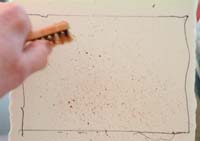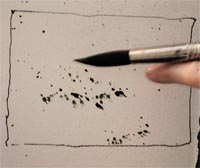-Spattering Watercolor Techniques:
For texture in certain situations, watercolor techniques such as splattering paint can be quite effective. This can be done in several ways. One…with a toothbrush, dipped into paint, and using your thumb, scrape over the bristles to let the paint splatter over the painting (mask off the areas where you don’t want the splatter. (and be sure you aren’t going to a dinner party that night if you have use a staining color like Sap Green. It will be underneath your fingernails!
Another way is to dip a damp (round) brush into a pool of color, and tap the brush over a finger of the opposite hand, allowing the paint to splatter on the page.

For a heavier spatter, use a brush dipped in pigment. Tap it against a finger to release the pigment onto the paper. The spatter will be rather bold spots as shown. The more water in the brush, the larger the spatter.

Spraying Watercolor Techniques:
- I use a trigger type sprayer to put droplets of water on the painting surface and then drop in color. The paint follows the droplets across the page, and since the droplets run into each other, the paint does not appear to be polka dots! I use this for painting all kinds of tree foliage.
You can also sprinkle water into paint that is already on the page (if the paint is still damp) and then blot if necessary to create texture. On canvas and Claybord®, the paint is easily lifted by blotting, as these surfaces do not absorb the paint.
Backwash Textures - Also called “Blooms”. As stated above, the blooms can be very effective. They are caused when the paint on the paper is still quite damp, and a drop of water or pigment that is very wet, is dropped on the surface. The excess water makes the pigment float to the edge of the puddle, creating a dark, jagged line around it. Sometimes this is good! Usually it is an accident, but I have been known to use if for certain effects, especially when painting flowers. |

